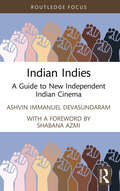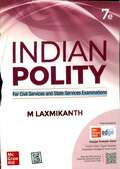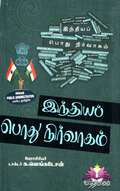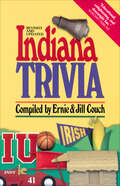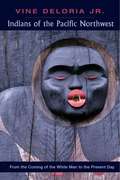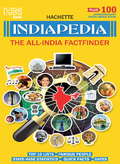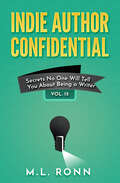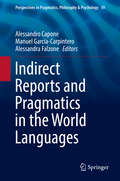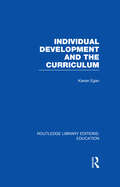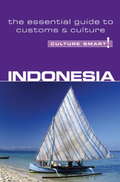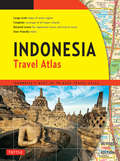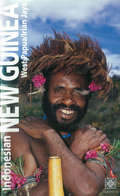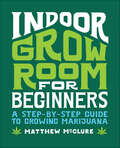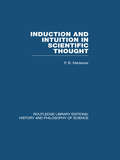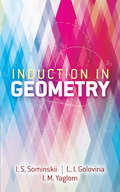- Table View
- List View
Indian Indies: A Guide to New Independent Indian Cinema (Routledge Focus on Film Studies)
by Ashvin Immanuel DevasundaramThis book offers a concise and cutting-edge repository of essential information on new independent Indian films, which have orchestrated a recent renaissance in the Bollywood-dominated Indian cinema sphere. Spotlighting a specific timeline, from the Indies’ consolidated emergence in 2010 across a decade of their development, the book takes note of recent transformations in the Indian political, economic, cultural and social matrix and the concurrent release of unflinchingly interrogative and radically evocative films that traverse LGBTQ+ issues, female empowerment, caste discrimination, populist politics and religious violence. A combination of essential Indie-specific information and concise case studies makes this a must-have quick guide to the future torchbearers of Indian cinema for scholars, students, early career researchers and a global audience interested in intersecting aspects of cinema, culture, politics and society in contemporary India.
Indian Political Thought
by Dr S. R. Myneni"Indian Political Thought" by Dr. S. R. Myneni explores the evolution of political ideas and institutions in India from ancient times to the modern era. Divided into five units, the book begins with Ancient Indian Political Thought, detailing its sources, features, and institutional structures. It proceeds to cover the philosophical contributions of Hindu scriptures like the Vedas, Arthashastra, and Smritis. Subsequent sections delve into Religious Political Thought, exploring Buddhist and Islamic perspectives, and analyze movements such as Liberalism, Marxism, and Sarvodaya. The final unit profiles modern Indian thinkers, including Gandhi, Nehru, Ambedkar, and Jaya Prakash Narayan, showcasing their contributions to democracy, social justice, and reform. Designed for political science students, the book adheres to university syllabi, combining scholarly insights with practical interpretations of governance and ethical leadership across Indian history.
Indian Polity - Competitive Exam: For Civil Services and State Services Examinations - 7th Edition
by M LaxmikanthThe "INDIAN POLITY 7th Edition" by M LAXMIKANTH is a comprehensive guide tailored for aspirants of India's Civil Services and State Services Examinations. The book breaks down the intricate facets of Indian Polity into digestible sections. In the preliminary examination section, it covers the broad spectrum of Indian governance, including the Constitution, Political System, Panchayati Raj, and Rights Issues. The main examination section delves deeper, discussing the historical underpinnings and evolution of the Indian Constitution, the functions and responsibilities of Union and States, and comparisons with other global constitutional schemes. Additionally, the book offers insights into the dynamics of coalition politics, emphasizing its fluid nature, the significance of compromise, and the challenges of operating on a minimum program. This edition serves as an essential resource, aiding students in navigating both preliminary and main stages of their examination journey.
Indian Polity: இந்திய அரசியல்: தமிழ் போட்டித் தேர்வுக்கான 1000 கேள்வி பதில்
by Tamil Competitive Examஇந்நூலில் இந்திய அரசியல் பற்றிய 1000 Q & A தமிழில் கொடுக்கப்பட்டுள்ளன.
Indian Public Administration: இந்திய பொது நிர்வாகம்
by Professor Dr. K. Venkatesanஇந்த நூல், நிரலாக்க நிரலாக்கத்தின் முழுவதிலும் அவசரமாகப் பரிசோதித்த ஒரு வழிகாட்டி. நிர்வாக என்பது முழுவதும் உதாரணங்களையும் அல்லது கட்டாயமாகப் உதவும் அனைத்து பரிசோதனைகளையும் சேர்ந்து அநுகரிக்கும். நிர்வாக அமைப்பின் பிரிவுகளையும், விளக்கமான புரிந்து கொள்ள பயனுள்ள உணர்வையும் கொண்டுகொள்ளும் வழிகாட்டிக் கொள்ளுகின்றது. நிர்வாகத்தின் பொருளாதாரங்களின் உருவாக்கத்தை அல்லது அதன் தரவுத்தாளை விளக்கப்படுத்தலில், அநிரந்தரமான அனுபாதங்களைக் குறித்து விளக்கமான அறிந்துகொள்ளும் வழிகாட்டியாக இந்த நூல் அமைந்துள்ளது.
Indian Society: For Civil Services Main Examination (GS Paper 1)
by M Senthil Kumar S RijeshThe book is designed in such a way to include each and every aspect of the syllabus prescribed by the UPSC.
Indiana Trivia
by Ernie Couch Jill CouchDiscover fascinating facts about Hoosier State history, sports, geography and more with this “educational, enlightening, and downright fun” trivia book (Kokomo Tribune).Indiana Trivia is the ultimate resource on the who, what, when, where, and how of the great state of Indiana. Filled with interesting questions and answers regarding well-known and not so well-known facts about the Hoosier State, Indiana Trivia will provide hours of entertainment and education. Easily adaptable for use with trivia format games, it focuses on the history, culture, people, and places of Indiana.
Indiana Wildlife Encyclopedia: An Illustrated Guide to Birds, Fish, Mammals, Reptiles, and Amphibians (Wildlife Encyclopedias)
by Scott ShupeIncluded are over 700 color photographs, depicting the different species of mammals, reptiles, amphibians, birds, and fish, while offering over 600 range maps to show their territory, along with basic information for the biology of each animal, Indiana's wildlife has always played an important role in the history of human beings inhabiting the state. Although the state&’s wildlife is still an important resource for human consumption, wildlife is also increasingly important in today&’s culture for its intrinsic, aesthetic value. For many Hoosiers, the age-old traditions of hunting and fishing have been replaced by a desire to simply observe wildlife and experience nature. But most Indianans are largely unaware of the diversity of species inhabiting their state. This volume is intended to provide an introduction to the state&’s fresh water fishes, amphibians, reptiles, birds, and mammals. In Indiana Wildlife Encyclopedia, nationally known naturalist Scott Shupe has collected information on all the native wildlife that reside in the Hoosier State. The fifth in a series of state wildlife encyclopedias, this book will be a handy, usable, layman&’s guide to Indiana's native wildlife. Shupe includes the size, habitat, and abundance of each species located in the state. Whether you&’re a lover of the outdoors, photography, or are looking to learn more about your state, this comprehensive guide will teach you about the wonderful wildlife that covers the water, earth, and skies of Indiana.
Indians of the Pacific Northwest
by Vine Deloria Jr. Steve Pavlik Billy Frank JrThe Pacific Northwest was one of the most populated and prosperous regions for Native Americans before the coming of the white man. By the mid-1800s, measles and smallpox decimated the Indian population, and the remaining tribes were forced to give up their ancestral lands. Vine Deloria Jr., named one of the most influential religious thinkers in the world, tells the story of these tribes' fight for survival, one that continues today. Billy Frank Jr. was the first recipient of Indian Country Today's American Indian Visionary Award. Steve Pavlik is a professor of Native American studies at Northwest Indian College.
Indiapedia: The All-India Factfinder
by Hachette IndiaALL YOU EVER WANTED TO KNOW ABOUT INDIA IS NOW AT YOUR FINGERTIPS! Tired of sifting through thousands of websites for school projects? Bored of flipping through thick history books for an overview of a dynasty? Sick of staring at maps to understand the land forms of the country? Going crazy searching the newspaper archives to understand the Reservation Bill? Don?t worry, help is at hand! Hachette India brings you a super compendium of information: Indiapedia: The All-India Factfinder. This useful reference book will introduce you to the different aspects of India, from history to economy, from geography to flora and fauna, from sports to cinema?an absolute must-have for every student to know more about their country and find detailed information for homework, essays, quizzes and general knowledge enhancement. Plus: 100 Special A-Z of facts about Incredible India!
Indie Author Confidential 12-15: Secrets No One Will Tell You About Being a Writer (Indie Author Confidential Anthology #4)
by M.L. RonnThis collection contains Volumes 12-15 of the groundbreaking, behind-the-scenes series of a working writer’s journey! Ever wondered what bestselling authors think about on a daily basis? M.L. Ronn is the author of many books of fiction and nonfiction. This book series is a diary of all the lessons he’s learning as he navigates how to master the craft of writing, marketing, and running a profitable publishing business. Most writers don’t talk about the everyday lessons they learn because they might seem mundane, boring, or obvious. Many only start talking about their success once they’ve achieved it. This book is the exact opposite: it’s about a writer learning how to be successful and documenting the process. The ideas in this book are what writers discuss over beers at writing conferences. They’re insider ideas—you may find them interesting and useful on your journey to becoming a successful writer. V1.0
Indie Author Confidential 12: Secrets No One Will Tell You About Being a Writer (Indie Author Confidential #12)
by M.L. RonnThe ground-breaking, behind-the-scenes look at a working writer continues with Vol. 12!Prolific writer M.L. Ronn (Michael La Ronn) shares his lessons learned on his journey to become a successful writer. You’ll discover writing, marketing, business, and other miscellaneous tips that you don’t hear every day.Covered in this volume: A change in Michael's strategy. Lessons in character tagging, a little-known but effective craft technique. A game-changing AI app that Michael built. Michael's thoughts on AI art. The information in this book is what writers discuss over beers at writing conferences. You may find it useful on your journey to becoming a successful writer. It just might make you more money and help you satisfy your readers, too.Are you ready to dive into the world of Indie Author Confidential? V1.0
Indie Author Confidential 15: Secrets No One Will Tell You About Being a Writer (Indie Author Confidential #15)
by M.L. RonnThe ground-breaking, behind-the-scenes look at a working writer continues with Vol. 15!Prolific writer M.L. Ronn (Michael La Ronn) shares his lessons learned on his journey to become a successful writer. You’ll discover writing, marketing, business, and other miscellaneous tips that you don’t hear every day.Covered in this volume: Lessons from a plethora of mega-bestseller novels. A new exercise Michael developed to strengthen his vocabulary. Experiments in AI editing. Adventures in fitness and nutrition. and more! The information in this book is what writers discuss over beers at writing conferences. You may find it useful on your journey to becoming a successful writer. It just might make you more money and help you satisfy your readers, too.Are you ready to dive into the world of Indie Author Confidential? V1.0
Indirect Reports and Pragmatics in the World Languages (Perspectives in Pragmatics, Philosophy & Psychology #19)
by Alessandro Capone Alessandra Falzone Manuel García-CarpinteroThis volume addresses the intriguing issue of indirect reports from an interdisciplinary perspective. The contributors include philosophers, theoretical linguists, socio-pragmaticians, and cognitive scientists. The book is divided into four sections following the provenance of the authors. Combining the voices from leading and emerging authors in the field, it offers a detailed picture of indirect reports in the world’s languages and their significance for theoretical linguistics. Building on the previous book on indirect reports in this series, this volume adds an empirical and cross-linguistic approach that covers an impressive range of languages, such as Cantonese, Japanese, Hebrew, Persian, Dutch, Spanish, Catalan, Armenian, Italian, English, Hungarian, German, Rumanian, and Basque.
Individual Development and the Curriculum (Routledge Library Editions: Education)
by Kieran EganThis book describes four ‘layers’ or stages of education – Mythic, Romantic, Philosophic and Ironic and shows how children at each stage most effectively learn, and how they can be helped towards educational maturity. While drawing on a wide range of philosophical and psychological literature, this new theory is primarily constructed from close observation of children in their common and intense imaginative engagements, and in everyday educational practice.
Indonesia - Culture Smart!
by Graham SaundersCulture Smart! provides essential information on attitudes, beliefs and behavior in different countries, ensuring that you arrive at your destination aware of basic manners, common courtesies, and sensitive issues. These concise guides tell you what to expect, how to behave, and how to establish a rapport with your hosts. This inside knowledge will enable you to steer clear of embarrassing gaffes and mistakes, feel confident in unfamiliar situations, and develop trust, friendships, and successful business relationships. Culture Smart! offers illuminating insights into the culture and society of a particular country. It will help you to turn your visit-whether on business or for pleasure-into a memorable and enriching experience. Contents include * customs, values, and traditions* historical, religious, and political background* life at home* leisure, social, and cultural life* eating and drinking* do's, don'ts, and taboos* business practices* communication, spoken and unspoken "Culture Smart has come to the rescue of hapless travellers." Sunday Times Travel "... the perfect introduction to the weird, wonderful and downright odd quirks and customs of various countries." Global Travel "...full of fascinating-as well as common-sense-tips to help you avoid embarrassing faux pas." Observer "...as useful as they are entertaining." Easyjet Magazine "...offer glimpses into the psyche of a faraway world." New York Times
Indonesia Travel Atlas Third Edition
by Periplus EditorsFinding your way around the various regions of Indonesia is a breeze with this handy Tuttle Travel Atlas. Designed for the adventurous traveler and containing all the maps you'll need on your explorations, this atlas includes many views that are available nowhere else.This Atlas is conveniently divided into the major regions of Indonesia: Jakarta, West Java, Central Java, East Java, Bali, Nusa Tenggara, Sumatra, Kalimantan, Sulawesi, Maluku and Papua. Each of the 144 maps in this atlas is presented in a logical, easy-to-follow manner, with emphasis on the most frequently-visited areas. All cities, towns, villages, places of interest and nature reserves are indexed for quick reference.Comprehensive: Detailed insets of major cities, travel destinations and business hubs in IndonesiaInformative: Precise locations of all popular sights, hotels, restaurants, temples, shopping malls and other essential locations.Practical: The handy size, well-designed key maps and comprehensive index help you find places you are looking for quickly.Reliable: The maps in this atlas are thoroughly researched and regularly updated by the leading publisher of Asia Pacific maps.
Indonesian New Guinea Adventure Guide
by David Pickell Kal MullerThis is the most complete guide to Indonesian New Guinea ever produced. Hundreds of pages of travel tips and dozens of lively articles cover every aspect of the island's history and geography, taking you to lots of rarely-visited places.Detailed maps of every town and region of Indonesian New Guinea are included, along with personal recommendations from our expert authors on how to get around, where to stay and eat, and how to get the best value for money.
Indonesian New Guinea Adventure Guide
by David Pickell Kal MullerThis is the most complete guide to Indonesian New Guinea ever produced. Hundreds of pages of travel tips and dozens of lively articles cover every aspect of the island's history and geography, taking you to lots of rarely-visited places.Detailed maps of every town and region of Indonesian New Guinea are included, along with personal recommendations from our expert authors on how to get around, where to stay and eat, and how to get the best value for money.
Indoor Cat: How to Enrich Their Lives and Expand Their World
by Laura J. Moss Lynn BahrCan an indoor cat live a happy, stimulating, and active life? A veterinarian and a journalist answer this question with a resounding "yes," and offer real-life guidance for opening up your cat's world, even if they stay within the confines of your home. There are many myths our culture perpetuates about domestic cats: they live longer indoors, sleep all day, are easy and low-maintenance pets, and can't be trained. Even the most well-meaning kitty caregiver will be surprised to learn that these long-held beliefs aren't necessarily based on facts, but instead reflect the many ways we have adapted our feline friends to our indoor, domesticated lifestyles.Indoor Cat, by Laura J. Moss, journalist and founder of Adventure Cats, and Lynn Bahr, a feline-only veterinarian, explores how to help cat owners understand a cat's perspective of their indoor homes, with practical ways to enhance cats' lives to the fullest and combat countless health and behavioral problems that result from indoor living, as well as raising the question: should every cat live exclusively indoors?Together with scientific studies, expert opinions from vets and behaviorists, and firsthand accounts and interviews, this informative and engaging full-color guide strives to reach compassionate cat owners looking for new ways to care for and connect with their feline companions.
Indoor Grow Room for Beginners: A Step-By-Step Guide to Growing Marijuana
by Matthew McClureGrow your own marijuana indoors with help from this comprehensive guideEven if you have no experience, growing marijuana at home is easy once you learn the basics. This step-by-step guide provides novice growers with simple instructions on how to set up an indoor growing space and nurture high-quality buds. Find advice for each stage of the process, from choosing the right space, equipment, and strains, to planting, caring for, and cultivating a thriving crop.In this guide to growing marijuana indoors, you'll find:An overview of the basics—Explore the anatomy and life cycle of the cannabis plant, the four fundamentals of growing marijuana, and common myths and misconceptions.The complete setup—Learn the pros and cons of growing marijuana in a closet, tent, or grow room, and get comprehensive instructions and equipment lists that work for any indoor setting.Visual guidance—Detailed diagrams and illustrations clearly explain complex concepts so you can grow cannabis at home with confidence.Tips for growing the best buds—Discover at-a-glance tables that make it easy to harvest hearty, seedless buds, with information on how to rig lighting, lay out your space, maintain proper nutrients, control pests, and prune your plants.Discover the joy of growing marijuana with this comprehensive guide to indoor cultivation for beginners.
Indoor Kitchen Gardening: Turn Your Home Into a Year-Round Vegetable Garden
by Elizabeth MillardAs featured in The New York Times, grow amazing, fresh, organic produce in your own home with this critically acclaimed indoor gardening manual.It takes just a few dollars and a few days for you to start enjoying fresh, healthy produce grown indoors. Imagine serving a home-cooked meal highlighted with beet, arugula, and broccoli microgreens grown right in your kitchen, accompanied by sautéed winecap mushrooms grown in a box of sawdust in your basement. Explore the expansive new world of growing and eating that can be discovered with the help of Indoor Kitchen Gardening.Author and Bossy Acres CSA co-owner Elizabeth Millard teaches you how to grow microgreens, sprouts, herbs, mushrooms, tomatoes, peppers, and more—all inside your own home, where you won’t have to worry about seasonal changes or weather conditions. In this guide, you will find: ·An introduction to growing edibles indoors, from defining your goals and choosing a space, containers, soil, and grow lights to troubleshooting common problems.·Guidance for growing crops perfectly suited to an indoor environment and that often have quick seed-to-harvest timeframes, such as microgreens, shoots, herbs, wheatgrass, sprouts, and mushrooms. ·Guidance for growing crops with shallow root systems that grow well indoors—such as radishes, carrots, lettuces, and tomatoes. ·Plenty of cheerleading to encourage your sense of adventure.Filled with photos and more than two hundred pages of do-it-yourself in-home gardening information and projects, Indoor Kitchen Gardening is your gateway to this exciting new growing method.“Well-written, clearly illustrated and full of personality.” —Northern Gardener“This is a great book for both beginners and seasoned gardeners.” —The American Gardener Magazine from The American Horticultural Society
Indoor Pollution
by Steve CoffelWe all know there are health hazards in the air outside, but this powerful new book warns that we aren't safe within our homes or offices either. The most comprehensive work available on this pressing issue covers publicized pollutants like asbestos, radon, and cigarette smoke, as well as the secret contaminants in our heating, electrical, and plumbing systems.From the Trade Paperback edition.
Induction and Intuition in Scientific Thought (Routledge Library Editions: History & Philosophy of Science)
by P B MedawarOriginally published in 1969. This book explains what is wrong with the traditional methodology of "inductive" reasoning and shows that the alternative scheme of reasoning associated with Whewell, Pierce and Popper can give the scientist a useful insight into the way he thinks.
Induction in Geometry (Dover Books on Mathematics)
by L.I. Golovina I. M. YaglomInduction in Geometry discusses the application of the method of mathematical induction to the solution of geometric problems, some of which are quite intricate. The book contains 37 examples with detailed solutions and 40 for which only brief hints are provided. Most of the material requires only a background in high school algebra and plane geometry; chapter six assumes some knowledge of solid geometry, and the text occasionally employs formulas from trigonometry. Chapters are self-contained, so readers may omit those for which they are unprepared. To provide additional background, this volume incorporates the concise text, The Method of Mathematical Induction. This approach introduces this technique of mathematical proof via many examples from algebra, geometry, and trigonometry, and in greater detail than standard texts. A background in high school algebra will largely suffice; later problems require some knowledge of trigonometry. The combination of solved problems within the text and those left for readers to work on, with solutions provided at the end, makes this volume especially practical for independent study.
